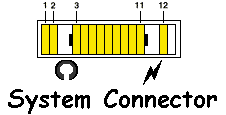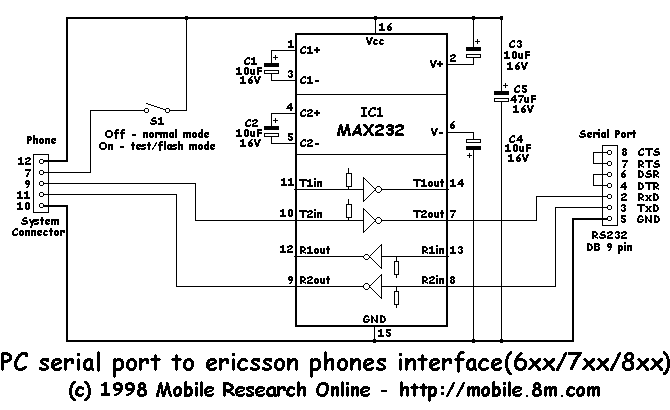 |
Secrets for Ericsson GH688
|
Most of the information presented in this page applies also to other
ERICSSON mobile phones. Namely GA628, GF788, GF788e, S868, SH888 and i888.
Secret Codes and Menus
*#06# to check the IMEI (International Mobile
Equipment Identity)
*#0000# to
reset the phone's menu-language to English.
Firmaware Revision and Text Strings
>*<<*<* to check the firmware revision.
CXC125065 - Cell phone's internal product
code.
PRG
970715 1515 - Firmware revision (date & time
stamp).
When showing the firmware revision you can press >
to go to 1-row text strings. After pressing YES
you can check the phone's text programming in currently selected language.
(298 entries). The complete key sequence is >*<<*<*>YES.
If you addicionally press > you go to n-row
text strings. After pressing YES you can check
the phone's text programming in currently selected language. (160 entries?).
The complete key sequence is >*<<*<*>>YES.
Service Provider Lock
The Service Provider(SP) Lock menu is used to lock the cell
phone to the SP's SIM card. Once the cell phone is locked to a specific
operator, if one inserts a SIM card from a different operator the phone
will refuse to accept it! The cell phone will however accept another SIM
card from the same operator.
To activate the menu press <**<.
"Lock to Network?" will be displayed. By pressing YES
you have 5 attempts to enter NCK.
If after activating the menu you press >
"Lock to Network subset?" will be displayed. By pressing YES
you have 5 attempts to enter NSCK.
NOTE: The same procedure is used for both
locking and unlocking.
2nd way to activate the menu
>*<*CLR< is another sequence to activate
the SP Lock menu.
If
an invalid code is entered all five times, the menu will exit and be deactivated!
Any further attempt to activate the NCK/NSCK lock Menu will result in the
response "Not allowed"!
Tricks...
Menu access without SIM inserted
Without the SIM card inserted in the phone press **04*0000*0000*0000#NO
when prompted for PIN. This way it is possible to enable Channel
Information without the need of a cable. But the phone lock when trying
to go beyond menu "Settings | Answering mode" or try to
access menu "Mail". I suppose this happens becaus the phone tries
to access information stored on the non-inserted SIM card
Free phone calls using the GH688/GA628/GF788...
... and a prepaid GSM SIM CARD. This is a "SIM card" which only has a certain
amount of credit on it (like a normal phonebox telecard)...
Q: It can be traced?
A: Yes, it can. But I think it is difficult because when detected,
TELECEL (my operator) only ends the call.
Step 1: dial the number and wait till the phone give you a click and
"Connecting" appears on the screen.
Step 2: press CLR and keep it pressed
till the dialled number is erased from the screen.
Step 3: press 0.
Step 4: press #.
Step 5: press NO.
Step 6: press NO and keep it pressed until
the phone is "turned off".
You can then still speak on the phone but the SIM card does not record
your calls which will lead to FREE phone calls in some countries... To
put the phone really off, you have to remove the battery.
NOTE: This
trick has only been reported working on PREPAID GSM cards only.
Tips
Shortcut for Last Dialed call menu...
If you for some reason don't want to enter the 'Last Dialed calls menu'
by using the 'YES' key you can use the following key stroke instead: First
'0' then '#'.
Bat. level indicator when turned OFF...
When the gh688 is turned off and the phone is not changing - the bat. level
can be seen for a short period of time by pressing the 'NO' key quick, once
(it has to be quick!) and then wait for about 2 sec. The bat. level will
now be shown in the display at its normal position.
Full Network Name...
You can see the Full Network Name by doing the following:
Go to the network menu, when the phone displays the networks available
(in 'Select net' and 'Edit list' menu) you can press * and you will see
the full name.
Software versions
Fixes in Software version<98xxxx>
Language bug fixes. No longer permits the 0# trick used for free phone
calls.
Fixes in Software version<971009>
After receiving an SMS the prompt Message read? stayed on the
screen until you pressed YES or NO. This new software eliminated this "feature"
and when you receive an SMS Message read? stays on the screen only
for a few seconds then changes into an envelope.
Fixes in Software version <970905>
(and Ericsson 788 - software version 970716) The error is described
as "MS unable to find HPLMN if 30 or more competitor ARFCN+s have greater
signal strength than the HPLMN."
That is: if there are 30 or more channels belonging to other carriers
which are stronger than the customer's home network, the phone will not
be able to find the customer's home network.
Fixes in Software version <970715>
The bug of the missing arrow on display when all diverting active.
Key lock key on display turned around , like in manual. (???)
An updated GSM operators' list.
Better and more solid reception.
Changing problem when turned OFF.
Pin-outs:
The Ericsson GH688 can be connected to a PC with a TTL/RS232 interface.

| Pin |
Designation |
Function |
Direction |
| 1 |
AFMS |
Audio Out |
Out |
| 2 |
ATMS |
Audio In |
In |
| 3 |
EXTAUD |
External Audio Accessoriy Sense |
In |
| 4 |
AGND |
GND (analog) |
- |
| 5 |
PORTHF |
Portable Hands Free |
In |
| 6 |
MUTE |
Mute |
Out |
| 7 |
VPPFLASH |
Test/Flash |
In |
| 8 |
VDD |
Logic Reference (+5V) |
Out |
| 9 |
TFMS/DFMS |
Data Out |
Out |
| 10 |
GND |
GND (DC and digital) |
- |
| 11 |
TTMS/DTMS |
Data In |
In |
| 12 |
DCIO |
DC I/O |
In/Out |
Short description
- AFMS - Audio From Mobile Station
- ATMS - Audio To Mobile Station
- EXTAUD - External Analog Audio Accessory Sense. 0V to enable
- AGND - Analog GND
- PORTHF - Portable Hands Free Sense. OV to enable Hands Free
- MUTE - Music Mute. +5V while scrolling or during a conversation.
- VPPFLASH - +5V to Enable test mode, +12V to Enable
test mode and set Flash voltage, during power up.
In this mode the serial line works at 115200 instead of the standard 9600.
- VDD - Logical Reference (+5V). Used do enable status on
accessories (over 100mA).
- TFMS/DFMS - Terminal adaptor equipment from Mobile Station/Data
from Mobile Station.
RS232 serial output at TTL level (0/5V).
- GND - Digital and DC GND.
- TTMS/DTMS - Terminal adaptor equipment to Mobile Station/Data
to Mobile Station.
RS232 serial input at TTL level (0/5V).
- DCIO - DC for phone battery recharging and External Accessory
power. Recharge at +7.2V (600mA).
NOTES:
Pins are numbered from left to right with keyboard up.
Comunication are at 9600 n 8 1.
Debug messages are text format, have trailing 0x0A0D and appear at 115200
baud.
Portable Handsfree Unit

| Pin |
Function |
Value |
| 1 |
Earphone |
16 Ohm |
| 2 |
Microphone |
<= 2 kOhm |
| 4 |
Analog GND |
| 5 |
Connected to GND (Pin 4) |
IMEI
IMEI stands for International Mobile Equipment Identity, is intended to
identify a mobile like a licence plate identifies a car and is supposed
to be unique in the world.
XXXXXX-XX-XXXXXX-X(-XX)
TAC FAC SNR * ??
| TAC |
= Type Approval Code (first 2 digits = country
code of the approval-country) |
| FAC |
= Final Assembly Code (51 and 61 are used for
Ericsson) |
| SNR |
= Serial Number. |
| * |
= Unknown (0 or 9). |
| ?? |
= Unknown. If this value does not exist * is 0 (Older phone versions). |
The IMEI is stored in the eeprom of the memory (and yes, if you know
how, it can be changed). More infos can be found here
(pdf).
Channel
Information
This shows the information of the Mobile Station with the Base Station.
It can be activated by selecting ON on the hidden menu "Settings
| Channel". This hidden menu can be enabled by software and a PC
cable, and is also visible when there is no SIM card inserted.
To enable the menu without the SIM card inserted you can either remove
the SIM after powering on the phone, or simply use the trick to access
the menus without a SIM card shown above. To remove the SIM after powering
on the phone do this: I already tried to both SIM card 8KB & 16KB and
it works fine.
-
Release the battery, unlock SIM Card from the slot.
-
Put the battery to the SH888, turn it on, wait 10 seconds until you hear
'tic tic tic'
-
Scroll menu by pressing > until 'Settings'
found press YES, now you are in Settings menu.
-
Release the battery 2mm from the phone slowly but you should keep the SH888
keep switch on.
-
Make sure your SIM Card surface is not contact/touch to the pins. (you
should use pin or something to make the SIM card surface is not contact
to the pin simcard in slot). Remember your phone should keep switch on.
-
Press < the you will see 'Channel' the
default is Off.
-
Press YES to activate Channel
-
Put the battery to the phone.
-
Press NO several times and you will see SH888
net monitor without software.
To activate this Channel menu you should contact the SIM Card to the Phone.
Example Channel Screen
+-------------+
||S778 19 43 |
|| 0 1 -- |
| |
+-------------+
Legend:
+-------------+
||0001 02 03 | Line 1
|| 4 5 06 | Line 2
| | Line 3
+-------------+
On standby only 0001 and 02 are available!
-
This represents the phone state.
-
i. When the phone is idle, this shows "Bxxx". "B" stands for "Broadcast
channel" (a logic GSM channel).
-
ii. When a phone call is in progress, this shows "Sxxx". S stands for "Stand
Alone Dedicated Control Channel" SDCCH for short.
-
iii. When the phone call established, this shows "Txxx". "T" Stands for
Traffic channel. The "xxx" thing is the channel number, 1-124.
-
This shows Rx Level. The value displayed is from 0 to 63. This is an indicator
on how good your reception is for the moment. 0 is a signal strength of
-110dBm. 63 is approx -45 to -50dBm. RXLEV is measured in dBm in such a
way that incoming signal equals -110.5 + RXLEV so that a RXLEV at 50 equals
an incoming signal strenght at -50.5 dBm (plus or minus 0.5dBm) For example
19 is the signal level. every block on the 4 segment level indicator on
the left of the screen represents 13.
-
This shows the output power in dBm.
-
This shows the timeslot. The timeslot is from 0 to 30. You can see it when
making a call.
-
This shows Rx Quality. Rx Quality is a measurement of how much error correction
is required to the speech. 0 indicates none and as the figure rises you
hear more pings and pongs on the speech as large parts of the frame are
missing. If you have more RxQ then 5, you are on good way to loose your
call. RxQuality reads 0-7.RXQUAL is measured by using a table weras the
biterrorrate or BER is interesting and measured in %
RXQUAL table
0 BER < 0,2 (%)
1 0,2 < BER < 0,4
2 0,4 < BER < 0,8
3 0,8 < BER < 1,6
4 1,6 < BER < 3,2
5 3,2 < BER < 6,4
6 6,4 < BER < 12,8 (here we have lost half a burst)
7 12,8 < BER
BER stands for Bit Error Rate.
-
This shows the timeing advance. The BS tells the MS to send before it should
just make sure that the MS burst is comming to the BS on the right time.
The TA is measured in halfbits so the distance to the BTS can be calculated
as 1,11 * TA/2. TimeingAdvance is a value from 0 to 63. Co-incidentely this
tells you how far you are from the base site in 550m chunks, up to the
theoretical max of 35.2 km.
Working on this
AT command supported and DATA communucation
These are THE ONLY AT commands supported by the ERICSSON GH688. Marked
on bold are commands sent and on blue
reply received.
All valid commands are echoed by the mobile phone. ME stands for Mobile
Equipment, TE stands for Terminal Equipment and TA stands for Terminal
Adaptor.
More infos on sh888 AT command are found in the official ericcson
AT command documentation (pdf).
NOTE: The sh888 does only support some basic at commands over the standard
rs232 (without ericsson software). All other
at commands are only supported after the ericsson software is installed
because the modem in the sh888 talk IRDA protocoll
over the wire (see AT*BINARY). So the sh888 is not the right choice
for non Windows machines which would like to communicate
via rs232. A direct IRDA connection (without a cable) is no problem
for all machines speaking IRDA protocoll
(The ericsson software is only available for windows)
' Don't what is the purpose of this
AT
OK
' GET MANUFACTURER IDENTIFICATION
' Implementation: mandatory for TA, optional for ME
AT+GMI
ERICSSON
OK
AT+CGMI
ERICSSON
OK
' GET MANUFACTURER MODEL IDENTIFICATION
' Implementation: mandatory for TA, optional for ME
AT+GMM
1050701
OK
AT+CGMM
1050701
OK
' GET MODEL REVISION IDENTIFICATION
' Implementation: mandatory for TA, optional for ME
' Returns: YearMonthDayHourMinute,A,B,I,J,T2
AT+GMR
YYMMDDHHmm,A,B,I,J,T2
OK
AT+CGMR
YYMMDDHHmm,A,B,I,J,T2
OK
ANSWER INCOMING PHONE CALL
' This command is only available when ringing.
ATA
DIAL PHONE NUMBER
' This command only dials voice calls.
' Format: ATD<number>;
' Returns OK when call is answered
ATD123;
OK
END PHONE CALL
' This ends an ongoing phone call
ATH
OK
' GET BATTERY CHARGE LEVEL
' Implementation: optional
' Format: AT+CBC=(bcs),(bcl)
' (bcs)
' 0 = ME is powered by the battery
' 1 = ME has a battery connected but not powered
by it
' 2 = ME does not have a battery connected
' 3 = Recorgnized power fault, calls inhibited
' (bcl)
' 0 = battery is exhausted, or ME does not
have a battery connected
' 1 ... 100 = battery has 1 ... 100 percent
of capacity remaining
AT+CBC=?
+CRC: (0,1),(0-100)
OK
AT+CBC
+CBC: 0,100
OK
' GET PHONE ACTIVITY STATUS
' Implementation: mandatory when ME can be operated from TE
' Return value:
' 0 = ready
' 1 = unavailable
' 2 = unknown
' 3 = ringing
' 4 = call in progress
' 5 = asleep
AT+CPAS=?
+CPAS: (1)
OK
AT+CPAS
+CPAS: 0
OK
' CELLULAR INCOMING CALL TYPE INDICATION RESULT CODE
' Implementation: mandatory when data or fax calls implemented
' Format: AT+CRC=(mode)
' (mode)
' 0 = disables extended format
' 1 = enables extended format
AT+CRC=?
+CRC: (0,1)
OK
AT+CRC?
+CRC: 0
OK
'Enter Frame mode
AT*BINARY
CONNECT
...and the phone is frame connected to the serial port.
If you dont reply it will send (char in HEX) 02 02 31 0C four times
with a second of interval. If you keep not replying it will send 02 02
01 01 four times also spaced a second.
' GET/SET FUNCTIONALITY LEVEL
' Set to 0 to switch off the phone.
' Returns 1 when the phone is on.
AT*ONOFF=?
*ONOFF: (0,1)
OK
AT*ONOFF?
*ONOFF: 1
OK
AT+CFUN=?
+CFUN: (0,1)
OK
AT+CFUN?
+CFUN: 1
OK
' Don't know what this is for but a value from 0 to 15 can be used.
' I suppose it is for setting baud rate.
AT*TRANSCH=?
OK
AT*TRANSCH=0
CONNECT




